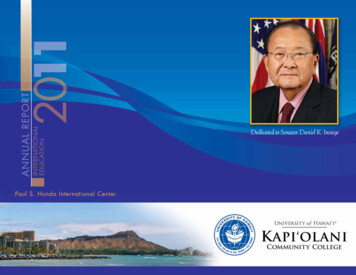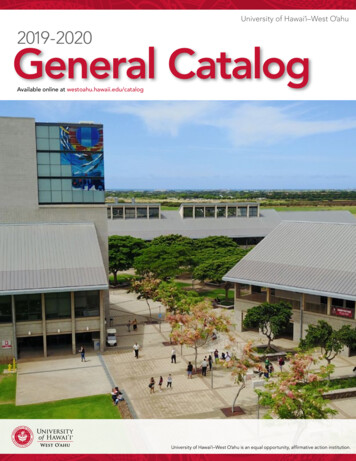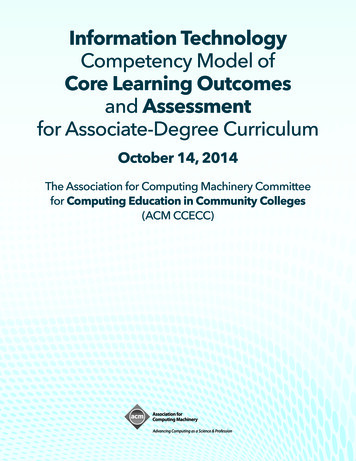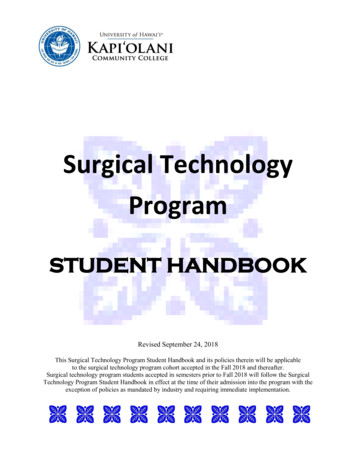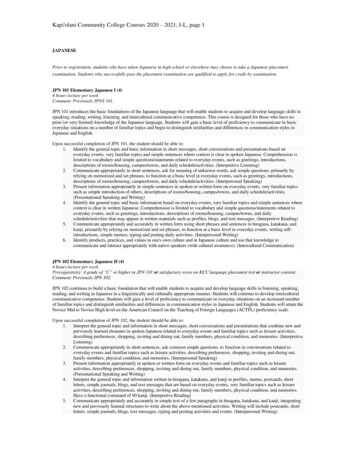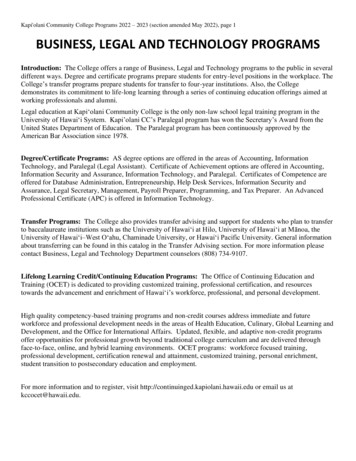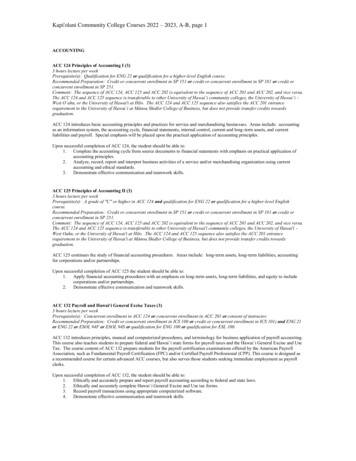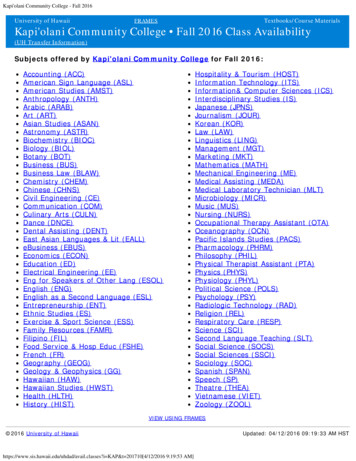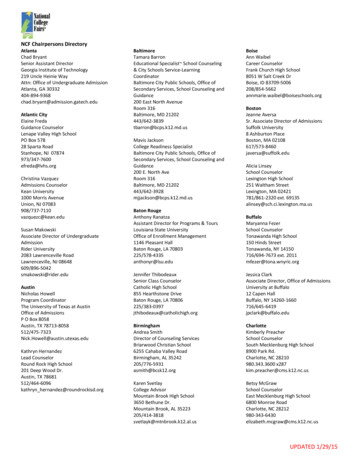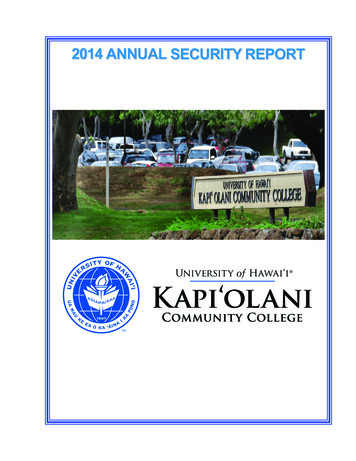
Transcription
ANNUALREPORT
The 2014 Annual Security Report (ASR) is prepared and published in compliance with the HigherEducation Opportunity Act and the Jeanne Clery Disclosure of Campus Security Policy and CampusCrime Statistics Act. The ASR is made available electronically on the Kapi’olani Community CollegeCampus Security website to all current and potential students and employees and to the general uploads/2013/11/ASR14.pdfThe 2014 Annual Security Report is based on crime statistical data and related information for the period ofJanuary 1, 2013 through December 31, 2013.2014 Annual Security ReportKapi’olani Community CollegePage 2 of 39
TABLE OF CONTENTSC L E R Y A C T C O M P L I A N C E C R O S S W A L K . 5I N T R O D U C T I O N . 8ABOUT THE INSTITUTION . 8GEOGRAPHICAL LOCATION . 9SPECIFIC FEDERAL LAWS REQUIRING SAFETY- AND SECURITY-RELATED DISCLOSURES . 9ANNUAL SECURITY REPORT . 10PREPARATION AND NOTIFICATION OF ANNUAL SECURITY REPORT . 10C A M P U S S E C U R I T Y . 12OVERVIEW . 12ENFORCEMENT . 12CRIME PREVENTION SERVICES . 14P O L I C Y S T A T E M E N T S . 16TIMELY WARNINGS . 16REPORTING OF CRIMINAL OFFENSES . 16VOLUNTARY – CONFIDENTIAL REPORTING . 17DISCLOSURES TO ALLEGED VICTIMS . 17DAILY CRIME LOG . 17EMERGENCY RESPONSE AND EVACUATION PROCEDURES . 18ACCESS AND SECURITY OF CAMPUS FACILITIES . 20CRIME PREVENTION AWARENESS PROGRAMS . 20ALCOHOL AND DRUG POLICY . 21SUBSTANCE ABUSE EDUCATION . 22WEAPONS POLICY . 22SEXUAL ASSAULT POLICY . 22SEX OFFENDER REGISTRY . 25C R I M E S T A T I S T I C S . 262014 Annual Security ReportKapi’olani Community CollegePage 3 of 39
DEFINITIONS AND GUIDELINES FOR INSTITUTIONS INR E P O R T I N G S T A T I S T I C S : . 27ON CAMPUS . 27NON-CAMPUS . 27PUBLIC PROPERTY . 27CLERY ACT GUIDELINES FOR REPORTING . 27DEFINITIONS OF CLERY ACT CRIMES . 28HATE CRIME AND OTHER REPORTABLE INCIDENTS . 30DEFINITIONS OF CLERY ACT GEOGRAPHY . 31A P P E N D I X A . 33CAMPUS SECURITY AUTHORITIES . 33LISTING OF CAMPUS SECURITY AUTHORITIES . 33A P P E N D I X B . 34CRIME PREVENTION AND SAFETY TIPS . 34A P P E N D I X C . 35CAMPUS MAP . 35CALL BOX LOCATIONS . 36A P P E N D I X D . 37WHERE TO GO FOR ASSISTANCE OR INFORMATION . 372014 Annual Security ReportKapi’olani Community CollegePage 4 of 39
CLERY ACT COMPLIANCE CROSSWALKThe table below is a crosswalk that is intended to assist in locating specific Clery Act compliancecomponents within this publication. The content of this crosswalk is consistent with Section VIIIAppendix E “Checklist for Campus Safety and Security Compliance” of The Handbook for CampusSafety and Security Reporting (2011; United States Department of Education) related to the AnnualSecurity Report.REFERENCEDESCRIPTIONPART IPOLICY STATEMENTSI.APOLICY STATEMENTS RELATED TO PROCEDURESFOR REPORTING CRIME AND OTHER EMERGENCIESProcedures for students and others to report criminalactions or other emergencies occurring on campusA statement concerning the campus’ response toinformation received related to criminal actions or otheremergencies occurring on campusPolicy for making timely warning reports to members of thecampus community regarding the occurrence of Clery Actreportable crimesPolicy for preparing the annual disclosure of crime 3-1I.A.3-2PAGE #’SList of titles of each person or organization to whomstudents and employees should report criminal offenses forthe purposes of making timely warnings and disclosure ofannual statistics; Campus Security AuthoritiesPolicy statements related to campus facilities andresidences related to safety and securityPolicies concerning security of and access to campusfacilities, including campus residences (residences asapplicable to the institution)Policy concerning security considerations used in the16-1716-171610-113316-252014, 16-25maintenance of campus facilitiesI.A.4Policies concerning campus law enforcement12-141.A.4-1The law enforcement authority of campus security personnel12-14I.A.4-2Policies concerning the working relationship of campussecurity personnel with state and local law enforcementagencies and whether the institution has agreements withsuch agenciesPolicies which encourage accurate and prompt reporting ofall crimes to the campus police (Campus Security Office)and the appropriate law enforcement agenciesA description of procedures, if any, that encourage pastoralcounselors and professional counselors, of an when theydeem appropriate, to inform the persons they arecounseling of any procedures to report crimes on avoluntary, confidential basis for inclusion in the annualdisclosure of crime statistics12-13I.A.4-3I.A.416172014 Annual Security ReportKapi’olani Community CollegePage 5 of 39
REFERENCEDESCRIPTIONPAGE #’SI.A.5A description of the type and frequency of institutionalprograms designed to inform students and employeesabout campus security procedures and practices and toencourage students and employees to be responsible fortheir own security and the security of othersA description of programs designed to inform students andemployees about the prevention of crimesPolicy concerning the monitoring and recording, throughlocal police agencies of criminal activity in which studentsengage at off-campus locations of student organizationsofficially recognized by the institution, including studentorganizations with off-campus housing facilities (asapplicable to institutions with housing)Policy regarding the possession, use and sale of alcoholicbeverages and enforcement of state underage drinkinglawsPolicy regarding the possession, use and sale of illegaldrugs and enforcement of federal and state drug lawsA description of any drug or alcohol abuse educationprogram as required under Section 120(a) through (d) ofHEAA statement that the institution will, upon written request,disclose to the alleged victim of a crime of violence (as thatterm is defined in Section 16 of Title 18, USC), or a nonforcible sex offense, the report on the results of anydisciplinary proceeding conducted by such institutionagainst a student who is the alleged perpetrator of suchcrime or offenseA statement regarding the institution’s emergency responseand evacuation procedures20-21N/AI.B.2A statement regarding missing student notificationprocedures (as applicable for institutions withhousing/residences)THE INSTITUTION’S CAMPUS SEXUAL ASSAULTPROGRAMS TO PREVENT SEX OFFENSES & THEPROCEDURES TO FOLLOW WHEN THEY OCCURA description of educational programs to promote theawareness of rape, acquaintance rape and other forcibleand non-forcible sex offensesProcedures students should follow if a sex offense occursI.B.2-1Procedures concerning who should be contacted22-25I.B.2-2The importance of preserving evidence for the proof of acriminal offense 7 I.B.To whom the alleged offense should be reported22-25I.B.3Information on a student’s option to notify appropriate lawenforcement authorities22-25I.B.3-1On-campus and local .A.13I.BI.B.1I.B.2-314, 20-21, 35N/A21-2221-2221, 3722-241822-2522-2522-252014 Annual Security ReportKapi’olani Community CollegePage 6 of 39
REFERENCEDESCRIPTIONPAGE #’SI.B.3-2A statement that institutional personnel will assist thestudent in notifying these authorities, if the studentrequests the assistance of these personnelNotification to students of existing on- and off-campuscounseling, mental health or other student services forvictims of sex offensesNotification to students that the institution will change avictim’s academic and living situations after an alleged sexoffense, and the options for those changes if thosechanges are requested by the victim and are reasonablyavailableProcedures for campus disciplinary action in cases of an22-25I.B.4I.B.5I.B.622-25, 3722-2522-25alleged sex offense22-25PART IIThe accuser and the accused are entitled to the sameopportunities to have others present during a disciplinaryproceedingBoth the accuser and the accused must be informed of theoutcome of any institutional disciplinary proceeding that isbrought alleging a sex offenseSanctions the institution may impose following a finaldetermination of an institutional disciplinary proceedingregarding rape, acquaintance rape or other forcible ornonforcible sex offensesINFORMATION ON WHERE TO FIND REGISTERED SEXOFFENDERS INFORMATION PROVIDED BY A STATECRIME STATISTICSII.AClery Act Offenses and Arrests and Referrals for ctionII.BClery Act Hate Crimes-II.CArrests and Referrals for Disciplinary Action-2014 Annual Security ReportKapi’olani Community CollegePage 7 of 39
I N T R O D U C T I O NABOUT THE INSTITUTIONThe University of Hawai‘i System (UH System) is currently comprised of three 4-year institutionsand seven 2-year institutions (community colleges), one of which is Kapi’olani Community College.Kapiʻolani Community College is the state's largest comprehensive community college withtechnical, occupational and professional programs in business education, food service andhospitality education, and nursing. It offers the state's most successful university transfer programas well as a well-respected STEM (Science, Technology, Engineering, and Mathematics) program.Nationally, Kapiʻolani Community College has been recognized for its programs in health sciencesand education for emergency medical services. Locally, KCC is well known for its culinaryprogram. Other students attend Kapiʻolani Community College as a starting point before movingon to the University of Hawaiʻi at Mānoa and other four-year universities to complete a bachelor'sdegree.Of all the community colleges in the University of Hawaiʻi System, KCC has the largest liberal artsstudent body with over (on average) 10,000 students enrolled annually. The campus has one ofthe nation's largest international student bodies and attracts students from over 100 nationsincluding very large numbers of students from Japan, Korea, China and Hong Kong because of itsprograms of study, links to the University of Hawaii - Mānoa, and proximity to Waikiki.Originally located at Pensacola Street and Kapiʻolani Boulevard (from which the school gets itsname), adjacent to President William McKinley High School in the Makiki community, KapiʻolaniCommunity College was established in 1946 as Kapiʻolani Technical College. The school wasadministered by the Territory of Hawaiʻi as one of its chief vocational schools, specializing in foodservice. In 1965, its curricula was modified and the college became an open-door public collegeadministered by the University of Hawaiʻi. As part of the realignment of programs, the schooladopted its current name.Kapiʻolani Community College gained national attention in 1976 when radiology instructors RolandClements and Harry Nakayama developed a new hip x-ray technique. In 1986, KapiʻolaniCommunity College's respiratory care program won a national award as an outstanding vocationaleducation program. Also in the late 1980s, Gallaudet University Regional Center opened at theFort Ruger campus.2014 Annual Security ReportKapi’olani Community CollegePage 8 of 39
Kapiʻolani Community College is currently in the process of establishing the Culinary Institute ofthe Pacific, already challenging other notable culinary schools in the world to provide quality talent.Among the alumni of this program are Alan Wong, Sam Choy, and Wayne Hirabayashi,cofounders of Hawaii Regional Cuisine.GEOGRAPHICAL LOCATIONKapi’olani Community College lies on opposite slope of Diamond Head, across from the entrance tothe Diamond Head National Monument. The campus is comprised of two locations that are separatedby approximately one-tenth (1/10th) of a mile in distance. The main campus can be found at 4303Diamond Head Road and is bordered by Diamond Head Road (Northwestern Border), Kilauea Avenue(Southeaster Border), 18th Ave (Northeastern Border), and Makapuu Ave (Southwestern Border), seeAppendix D for the campus location and map. Another undeveloped location can be found on theformer Cannon Club location. This location is accessible along Diamond Head Road. There is noother bordering street. The campus population includes more than 10,000 credit and non-creditstudents each semester. On any given semester, depending on our student population size, thecampus employs approximately 500 full and part time employees.As defined by the Clery Act, disclosure of statistics for certain reportable crimes will be based uponthe location of the crimes. Maps that delineate the Clery Act geographical boundaries for bothcampuses are located in Appendix D.SPECIFIC FEDERAL LAWS REQUIRING SAFETY- ANDSECURITY-RELATED DISCLOSURESIn 1990, Congress enacted the Crime Awareness and Campus Security Act of 1990 (Title II of PublicLaw 101-542) that was later amended and renamed the Jeanne Clery Disclosure of Campus SecurityPolicy and Campus Crime Statistics Act (also known as the Clery Act).The Clery Act requires all postsecondary institutions, that participate in the Higher Education Act(HEA) Title IV student financial assistance programs, to meet annual performance measures related tosafety, security, and emergency management. One such measure is to publicly disclose specific crimestatistics and safety- and security-related information by way of an Annual Security Report (ASR)which must be published and disseminated (or provide notice of its availability) by October 1 of eachyear.2014 Annual Security ReportKapi’olani Community CollegePage 9 of 39
In 2008, the Higher Education Opportunity Act (HEOA; Public Law 110-315) was reauthorized andexpanded the elements of the HEA. The HEOA further amended the Clery Act, and created additionalsafety and security performance and disclosure requirements for postsecondary institutions.The Violence Against Women Reauthorization Act of 2013 (Public Law 113-4) amended the ViolenceAgainst Women Act of 1994 (VAWA) which also added safety- and security-related performance anddisclosure requirements.This Kapi‘olani Community College 2014 Annual Security Report has been published in accordancewith the disclosure and information requirements of the current amended versions of the Clery Act, theHEOA, and the VAWA.ANNUAL SECURITY REPORTKapi’olani Community College is firmly committed to providing a safe and secure learning andworking environment. Policies and procedures are designed to provide precautionary measures toprotect persons and property. The entire Kapi’olani Community College community should exercisegood judgment and take appropriate precautions to reduce the possibility of becoming the victim of acrime-related event on campus.The 2014 Annual Security Report (ASR) is prepared and published in compliance with the HigherEducation Opportunity Act (HEOA) and the Jeanne Clery Disclosure of Campus Security Policy andCrime Statistics Act (Clery Act). These federal laws require colleges and universities to: Publish an annual security report containing three years of selected crime statistics and certaincampus security policy statements. Disclose crime statistical data for the campus, public areas immediately adjacent to the campus,and specific non-campus facilities that are owned or operated by the college and university.PREPARATION AND NOTIFICATION OF ANNUAL SECURITYREPORTThe Vice-Chancellor of Administrative Services Office in conjunction with the Auxiliary ServicesDivision coordinates the collection, publication, and dissemination of the ASR for Kapi’olaniCommunity College. The primary source of statistical data comes from the Campus Security Officeto whom crimes and incidents are generally reported. However, because not all incidents arereported to Campus Security, other sources are sought for statistical data. These sources includethe following: Designated Campus Security Authorities (other than Campus Security) Honolulu Police Department2014 Annual Security ReportKapi’olani Community CollegePage 10 of 39
Department of Public Safety-Sheriffs Division Department of Land and Natural Resources, Division of Conservation and ResourceEnforcementPlease note that only the statistics are collected. No identifiable information on the victim or suspectis disclosed to the college.Upon completion of the annual report, a mass email notification is sent to all current students, faculty,and staff providing the website a d d r e s s to access this report.A hardcopy of this report is also available for viewing in the library (for review and reference only).Current and prospective students and employees may make a request 36 hours prior to obtainone hardcopy of the report from the Vice-Chancellor of Administrative Services Office (contact 808734-9531 or come to Ilima Building, room 211). The ASR is also available online to current andprospective students, faculty, staff, and the general public ads/2013/11/ASR14.pdfASR POINT OF CONTACT INFORMATIONAll communication related to this ASR are to be addressed in writing to the following office:Kapi‘olani Community CollegeAttention:Vice Chancellor for Administrative Services4303 Diamond Head RoadHonolulu, Hawai'i 96816Should there be any amendment to this ASR, an email notice will be sent to the campuscommunity. The cover page will reflect: “Revised as of: [Date]”). The revised version willalso be posted on the campus website for public download.2014 Annual Security ReportKapi’olani Community CollegePage 11 of 39
CAMPUS SECURITYOVERVIEWEach Campus Security Department at each of the institutions in the University of Hawai‘i System isindependently administered. Security services for Kapi’olani Community College are administeredthrough Kapi’olani Community College’s Administrative Services Division. Security services areprovided by the Campus Security Office. The unit includes two (2) University Security Officer (USO) IIpositions and six (6) USO I positions. The college also contracts security services on a limited basis.These services are utilized to supplement the workforce and provide additional coverage asnecessary.Together, campus security officers and contract security officers provide patrol and other securityservices 24-hours a day, 365-days a year. The Campus Security Office is located in the Ohia Buildingon the first floor, Room 104. Security officers are available by telephone at 734-9900 or by campustelephone at x9900.** Safety Tip **Enroll in UH ALERT for emergency email and text message MENTUSO’s are charged with upholding federal, state, and local laws in addition to the rules, regulations,and policies governing the University of Hawai‘i and Kapi’olani Community College. In addition,USO’s and contract security personnel are not sworn police officers, do not have police powers, andare not authorized to carry firearms. Security officers may detain individuals involved in the violationof laws and those involved in criminal acts they personally view, or those positively identified ashaving committed such an act by victims or witnesses until such time that the Honolulu PoliceDepartment (HPD) arrives to take custody of the individual(s). Any campus incident requiring anarrest is referred to HPD.The Campus Security Office remains in communication with HPD and will occasionally work withother law enforcement agencies including the State of Hawai‘i’s Department of Public Safety (DPS),the Federal Bureau of Investigation (FBI), and the Department of Homeland Security, among others.Campus Security maintains an open and reciprocal relationship with these agencies utilizing theirresources and expertise to gather crime-related information, reports, and statistics. The HPD2014 Annual Security ReportKapi’olani Community CollegePage 12 of 39
remains responsible for investigating all criminal activity that occurs on all University of Hawai’icampuses, including Kapi’olani Community College.Though no formal agreements exist between the agencies, Kapi‘olani Community College, as a statelevel agency, is recognized in local-, state- and federal-level emergency management plans. The lawenforcement agencies are also identified in those plans as members of the State Law EnforcementCoalition (SLEC). Certain federal and state-sponsored training for SLEC personnel are often openedto include Kapi‘olani Community College personnel.ENCORCEMENT AND CAMPUS SECURITY’S RELATIONSHIP TOTHE STUDENT CONDUCT CODEThe University of Hawai‘i (UH) System “Student Code of Conduct” (Executive Policy E7.208 Universityof Hawai‘i Systemwide Student Conduct Code) Section IV.A: Jurisdiction of the UH Student ConductCode, states: “The UH Student Conduct Code shall apply to conduct that occurs on UH premises, atUH sponsored activities, in distance/on-line courses and events, and to off-campus conduct thataffects the UH Community and/or the pursuit of its objectives. Each student shall be responsible forhis/her conduct from the time of application for admission through the actual awarding of a degree.Conduct that occurs before classes begin or after classes end, as well as during the academic yearand during periods between terms of actual enrollment (and even if his/her conduct is not discovereduntil after a degree is awarded), is subject to the Student Conduct Code.” Additionally, Section IV.B:Conduct - Rules and Regulations, item #8 states: “Failure to comply with any directions of UH officialsor law enforcement officers acting in performance of their duties and/or failure to provide identificationto these persons when requested to do so.”In order to maintain a safe and secure educational environment, Honolulu CC Campus Securitypersonnel may encounter circumstances that will require obtaining personal identity information fromstudents at on- and off-campus properties, as well as requiring acceptance of guidance and direction.Students are encouraged to review their “Student Code of Conduct” and in order to better assist thecampus administration in their endeavor to help preserve a positive learning environment for all Othersin the campus community such as faculty, staff, and contractors are guided by their respectiveprovisions of conduct as identified by their employers.The Student Conduct policy can be found cies/conduct code/The Student Conduct code can be found ulu.hawaii.edu/files/policies-studentconduct 0.pdf2014 Annual Security ReportKapi’olani Community CollegePage 13 of 39
SECURITY WORKFORCE TRAININGState-Employed USOs are licensed professionals with the State of Hawai‘i, Department of Commerceand Consumer Affairs, in accordance with the Hawaii Revised Statute (HRS) Chapter 463-10.In addition to completing the training requirements for licensure, USOs must also complete initialcertification and, thereafter, regular recertification/refresher training on cardiopulmonaryresuscitation/first aid/automated external defibrillator; defensive tactics training; safe operation ofmotorized vehicles; safety measures to mitigate against blood borne pathogen exposure; and, safetymeasures in response to fire/chemical hazards.USOs also are trained on their responsibilities under the Clery Act; and, they are required tocomplete courses in the National Incident Management System (NIMS) and the Incident CommandSystem (ICS), which are the operational, and command/control protocols utilized by all firstresponder agencies throughout the nation.Contract security personnel are subject to the same DCCA licensure requirements as the USOs.Contract personnel who are assigned to any University of Hawai‘i Community College are alsoexpected to meet all the initial certifications and recertification/refresher training requirements as theUSOs (with the exception of the defensive tactics training). Additionally, contract security personnelmust also complete NIMS/ICS training.CRIME PREVENTION SERVICESSecurity officers, including contract security, conduct regular patrolling of the campuses by eithervehicle and/or by foot. Security officers perform an array of public safety services, including, but notlimited to: Working with victims and alleged victims in completing incident reports; Investigating crimes and working with other college or university offices, or lawenforcement, in meeting all internal investigation requirements under federal law; Responding to medical, fire and other disaster emergencies; Responding to all traffic accidents that occur on the college’s property; Upholding of university rules and local or federal laws that regulate the use of alcohol,drugs, and weapons; Inspecting campus facilities that facilitate safety (i.e., lighting, shrubbery), and other relatedcampus security services; Providing first responder assistance in emergency first-aid, cardiopulmonary resuscitation(CPR), automated external defibrillator (AED); Crowd control for college events;2014 Annual Security ReportKapi’olani Community CollegePage 14 of 39
Managing overall campus aggressive and/or disturbing behavior.University Security Officers also provide lock-out services within college and/or departmentprocedural guidelines and policies.2014 Annual Security ReportKapi’olani Community CollegePage 15 of 39
POLICY STATEMENTSTIMELY WARNINGSIn the event that a situation arises, either on or off campus, that poses an immediate or ongoingthreat, a campus-wide timely warning will be issued to the campus community. The timely warningnotification will be issued by one of the following offices, depending upon the circumstances of thesituation; Chancellor’s Office, the Vice-Chancellor of Administrative Services Office, Vice-Chancellorof Academic Affairs Office, or the Campus Security Of
and seven 2-year institutions (community colleges), one of which is Kapi'olani Community College. Kapiʻolani Community College is the state's largest comprehensive community college with technical, occupational and professional programs in business education, food service and hospitality education, and nursing.
